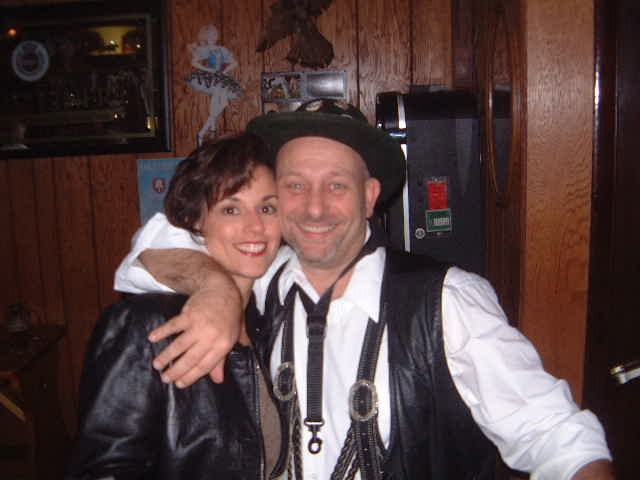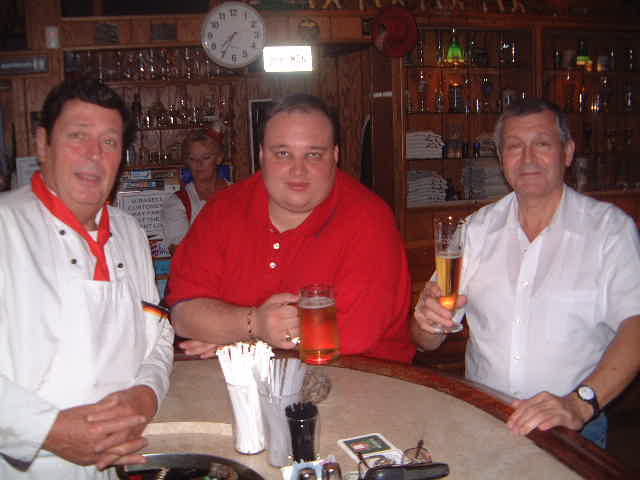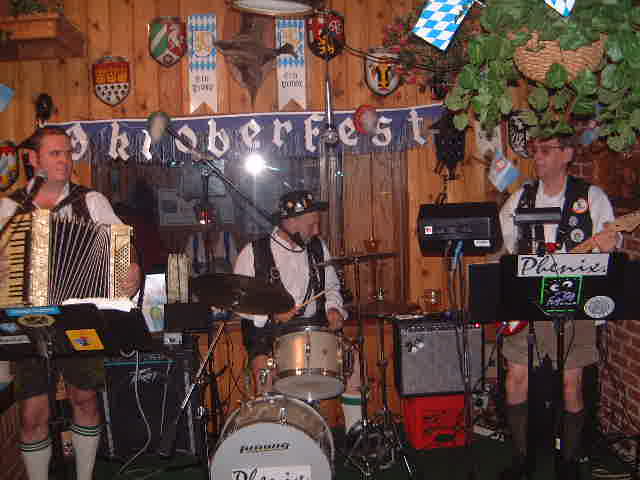 Though lesser known than its Lincoln Square counterparts, Mirabell Restaurant & Lounge should be considered when you’re hankerin’ for Weiner Schnitzel. Mirabell’s 30+ years of serving the quiet Irving Park community is especially impressive considering the gradually receding German population in the city and popular interest in the old country being increasingly confined to Oktoberfest. Mirabell’s notoriety is largely due to its extensive selection of top-notch German/Austrian food and beer. Just thinking about it makes me hungry. Add to that regular oompah band performances and beer garden in the summer, and you’ve got your next destination when you want that feel of a stein in your hand.
Though lesser known than its Lincoln Square counterparts, Mirabell Restaurant & Lounge should be considered when you’re hankerin’ for Weiner Schnitzel. Mirabell’s 30+ years of serving the quiet Irving Park community is especially impressive considering the gradually receding German population in the city and popular interest in the old country being increasingly confined to Oktoberfest. Mirabell’s notoriety is largely due to its extensive selection of top-notch German/Austrian food and beer. Just thinking about it makes me hungry. Add to that regular oompah band performances and beer garden in the summer, and you’ve got your next destination when you want that feel of a stein in your hand.
Mirabell is located on Addison, about two blocks east of the Kennedy Expressway (I-90) and just west of Elston. Even though there’s plenty of activity in the area, don’t count on finding a cab so you’ll probably want to drive or take the Addison #152 bus. Free parking is available across the street in the K-Mart lot. There at the corner of St. Louis Avenue and Addison Street, you’ll find a two-story building with a first floor exterior decked out in classic German Fachwerk style of half-timbered, criss-crossing beams. The second floor features more of a traditional brick façade in the Chicago style. In summer, what was once a small garden of the seedling variety has been cemented over and turned into a garden of the rathskeller variety. The outdoor patio is enclosed by a black wrought-iron fence and serves as a rather pleasant beer garden, with a smattering of tables, chairs, cement planters, and a pine tree in the middle sporting a lantern. In winter, the space is filled with the finest plasticular Christmas decorations. The entrance to Mirabell can be found along Addison as the door opening out onto St. Louis serves only the beer garden.
 Step through the outer wooden door and you’ll find a double-doored entryway with a payphone and “Herzlich Wilkommen” (roughly translated to mean “A hearty welcome to you”) carved into a wooden sign above the inner door. Once inside, you’ll immediately encounter the main bar area. This room features a white drop ceiling, faux wood paneling, a red-carpeted floor, a few TVs, and a worn wooden bar along the west side of the room that is rounded at both ends and sports enough burgundy-padded stools to accommodate about 15 people. A collection of beer steins and glasses is displayed behind the register across from the far end of the bar that is located near a glass case with more glassware and t-shirts for sale. At the other end of the bar is a panoramic picture of Wrigley Field and an autographed photo of Dick Butkus. A Bitburger sign hangs above the bar, next to its Budweiser counterpart complete with circling Clydesdale horses. Below that, you’ll find a good selection of German ale, highlighted by the following: Spaten, Julius Echter, Warsteiner, Würzburger, Bitburger, and Gösser (Austrian) on tap. BBK, Paulaner, Hofbrau, Stiegl, Radeberger, Franziskaner Dunkel, and the very non-German Stella Artois. There’s over 35 different beers in all. All beer is satisfyingly served in steins, except for Weiss varieties that are served in tall fluted glasses. Not a fan of the barley sciences? Then check out the impressive variety of German liquor and aperitifs. In addition to such staples s Goldschläger, Rumpleminze and Jägermeister, you’ll find Liillehammer, Gold Wasser (a Goldschläger-like substance), Apfel Korn, Kirschwasser, Edlelkirsch, Kroatzbeere, Jager (Smokie Dog), Bärenjäger, Licor 43, Escorial Green, Underberg, Herrenkirsch Pür-D-Schatz, Jagetee, Mirabell yellow plum brandy, Kabanes, Persico (Cherry Peach), Kummle, Obstler, Blackhaus, und Westfalen. In a word, fantastich!!! Just be careful. I once heard of a guy that got loaded after a Cubs game at Mirabell and proceeded to walk down the shoulder of the Kennedy towards downtown afterwards as, to him, this was his most direct and obvious way home. I wouldn’t recommend doing the same…
Step through the outer wooden door and you’ll find a double-doored entryway with a payphone and “Herzlich Wilkommen” (roughly translated to mean “A hearty welcome to you”) carved into a wooden sign above the inner door. Once inside, you’ll immediately encounter the main bar area. This room features a white drop ceiling, faux wood paneling, a red-carpeted floor, a few TVs, and a worn wooden bar along the west side of the room that is rounded at both ends and sports enough burgundy-padded stools to accommodate about 15 people. A collection of beer steins and glasses is displayed behind the register across from the far end of the bar that is located near a glass case with more glassware and t-shirts for sale. At the other end of the bar is a panoramic picture of Wrigley Field and an autographed photo of Dick Butkus. A Bitburger sign hangs above the bar, next to its Budweiser counterpart complete with circling Clydesdale horses. Below that, you’ll find a good selection of German ale, highlighted by the following: Spaten, Julius Echter, Warsteiner, Würzburger, Bitburger, and Gösser (Austrian) on tap. BBK, Paulaner, Hofbrau, Stiegl, Radeberger, Franziskaner Dunkel, and the very non-German Stella Artois. There’s over 35 different beers in all. All beer is satisfyingly served in steins, except for Weiss varieties that are served in tall fluted glasses. Not a fan of the barley sciences? Then check out the impressive variety of German liquor and aperitifs. In addition to such staples s Goldschläger, Rumpleminze and Jägermeister, you’ll find Liillehammer, Gold Wasser (a Goldschläger-like substance), Apfel Korn, Kirschwasser, Edlelkirsch, Kroatzbeere, Jager (Smokie Dog), Bärenjäger, Licor 43, Escorial Green, Underberg, Herrenkirsch Pür-D-Schatz, Jagetee, Mirabell yellow plum brandy, Kabanes, Persico (Cherry Peach), Kummle, Obstler, Blackhaus, und Westfalen. In a word, fantastich!!! Just be careful. I once heard of a guy that got loaded after a Cubs game at Mirabell and proceeded to walk down the shoulder of the Kennedy towards downtown afterwards as, to him, this was his most direct and obvious way home. I wouldn’t recommend doing the same…
 From the main barroom, you’ll find access to two dining rooms on either side. At the end of the bar on your left, just past the coolers, is the portal to the once non-smoking dining room. This sunny room during the day is filled with several low-slung wooden tables with green tablecloths, two orange booths on the north side of the room adorned with curving trellis above, a two-toned orange banquette along the west wall, wooden coats of arms, and enough taxidermy to make the owners of Will’s Northwoods Inn jealous. The décor also includes a stuffed deer head wearing a Kaiser helmet, a collection of porcelain and metal plates on the wall (mostly German but also some patriotic American), antlers, and Bavarian murals including a man in lederhosen with his dog. A stuffed pheasant “flies” over the entrance to the beer garden, comprised of a set of double, glass-paned doors. A ceramic beer stein at least three-and-a-half feet tall stands at the south end of the room, to the left of the windows. Nice.
From the main barroom, you’ll find access to two dining rooms on either side. At the end of the bar on your left, just past the coolers, is the portal to the once non-smoking dining room. This sunny room during the day is filled with several low-slung wooden tables with green tablecloths, two orange booths on the north side of the room adorned with curving trellis above, a two-toned orange banquette along the west wall, wooden coats of arms, and enough taxidermy to make the owners of Will’s Northwoods Inn jealous. The décor also includes a stuffed deer head wearing a Kaiser helmet, a collection of porcelain and metal plates on the wall (mostly German but also some patriotic American), antlers, and Bavarian murals including a man in lederhosen with his dog. A stuffed pheasant “flies” over the entrance to the beer garden, comprised of a set of double, glass-paned doors. A ceramic beer stein at least three-and-a-half feet tall stands at the south end of the room, to the left of the windows. Nice.
 The dining room where smoking was once permitted can be found through a set of wooden doors and across from the main bar, at the east end of the building. Also known as the “Garden Room” because of its plethora of foliage and natural light coming in from the skylights, this dining area looks anything but smoky because of its significantly larger size and arched ceiling. The space holds over a dozen low-slung tables that seat between two and six each, and also features exposed brick walls with recessed shelving that displays an array of additional Teutonic tchotchkes. Oak cabinetry at the east end of the room holds even more German drinking artifacts as well as Hummel figurines. In both dining rooms and the bar, German oompah music can be heard in the background and live at night when the real deal takes up a spot in the northeast corner of the Garden Room. The latter results in a slurry of energetic toasts and bashing of steins.
The dining room where smoking was once permitted can be found through a set of wooden doors and across from the main bar, at the east end of the building. Also known as the “Garden Room” because of its plethora of foliage and natural light coming in from the skylights, this dining area looks anything but smoky because of its significantly larger size and arched ceiling. The space holds over a dozen low-slung tables that seat between two and six each, and also features exposed brick walls with recessed shelving that displays an array of additional Teutonic tchotchkes. Oak cabinetry at the east end of the room holds even more German drinking artifacts as well as Hummel figurines. In both dining rooms and the bar, German oompah music can be heard in the background and live at night when the real deal takes up a spot in the northeast corner of the Garden Room. The latter results in a slurry of energetic toasts and bashing of steins.
 While drinking pitchers of BBK and gettin’ your freak on to the sounds of the Phoenix Oompah Band may be more than enough, the main draw for patrons is the fine selection of German-Austrian specialties. Such Old World classics include: Sauerbraten, Beef Roulade, Schweinebraten (roast pork loin), Ox Tail, Königsberger Klopse (veal dumplings), Kassler Ripchen (smoked pork loin), and the infamous “Frankfurter Bean Pot” (a “mighty mélange of kassler ripchen, thüringer, frankfurters, green beans and potatoes,” according to Pat Bruno of the Sun-Times). Mirabell also offers more Schnitzel than you can shake a stick at, as part of the self-described German Schnitzel Bank: the Original Wienerschnitzel (pan fried), Pariser (folded in eggs and sautéed in butter), Zigeuner (sauted with green peppers, onions, tomatoes, mushrooms and bacon), and Kloster (cordon bleu). All schnitzel dishes are served with spätzle, heavenly spätzle. Starters include herring in wine sauce, Hackepeter (steak tartar) on rye, escargot, and both Bratwurst and Thüringer plates. Chicken wings, jalapeño poppers and fried chicken tenders are also available for the skittish. Glühwein, cheesecake and strudel are available afterwards. Lunch is served from 11:30am to 2:30pm and dinner runs from 5-10pm during the week and until 11pm on Fridays and Saturdays. Personally, I have found the Hungarian-style goulash to be excellent (better than the iceberg lettuce salad), the beef roulade fantastic and the sauerbraten superb. The complimentary bread basket is also a nice touch and the sauerkraut prepared with caraway seeds and a bit of bacon is the only way to eat it. Gösser Dark washed it all down with no complaints. The waitress even commented that one patron was once heard exclaiming, “This is the best beer I’ve ever had!” while sober. While Gösser Dark is very good, I wouldn’t go that far. As for the prices, brace yourself: an average meal will set you back $16, and $23 for Wienerschnitzel (if you get pork instead of veal, you save $5 and it is equally as good. What is very disappointing is that the Bratwurst, Frankfurter and Thüringer plates all go for $15 each. Upon seeing this, I wanted to ask for the “local” menu as this seems like tourist prices, only that even the most inebriated Cub fan wouldn’t pay this following a long day at Wrigley Field. All of the above is served by stout, older Germanic women dressed in colorful traditional dresses, lacy white blouses and tiny hats with white feathers.
While drinking pitchers of BBK and gettin’ your freak on to the sounds of the Phoenix Oompah Band may be more than enough, the main draw for patrons is the fine selection of German-Austrian specialties. Such Old World classics include: Sauerbraten, Beef Roulade, Schweinebraten (roast pork loin), Ox Tail, Königsberger Klopse (veal dumplings), Kassler Ripchen (smoked pork loin), and the infamous “Frankfurter Bean Pot” (a “mighty mélange of kassler ripchen, thüringer, frankfurters, green beans and potatoes,” according to Pat Bruno of the Sun-Times). Mirabell also offers more Schnitzel than you can shake a stick at, as part of the self-described German Schnitzel Bank: the Original Wienerschnitzel (pan fried), Pariser (folded in eggs and sautéed in butter), Zigeuner (sauted with green peppers, onions, tomatoes, mushrooms and bacon), and Kloster (cordon bleu). All schnitzel dishes are served with spätzle, heavenly spätzle. Starters include herring in wine sauce, Hackepeter (steak tartar) on rye, escargot, and both Bratwurst and Thüringer plates. Chicken wings, jalapeño poppers and fried chicken tenders are also available for the skittish. Glühwein, cheesecake and strudel are available afterwards. Lunch is served from 11:30am to 2:30pm and dinner runs from 5-10pm during the week and until 11pm on Fridays and Saturdays. Personally, I have found the Hungarian-style goulash to be excellent (better than the iceberg lettuce salad), the beef roulade fantastic and the sauerbraten superb. The complimentary bread basket is also a nice touch and the sauerkraut prepared with caraway seeds and a bit of bacon is the only way to eat it. Gösser Dark washed it all down with no complaints. The waitress even commented that one patron was once heard exclaiming, “This is the best beer I’ve ever had!” while sober. While Gösser Dark is very good, I wouldn’t go that far. As for the prices, brace yourself: an average meal will set you back $16, and $23 for Wienerschnitzel (if you get pork instead of veal, you save $5 and it is equally as good. What is very disappointing is that the Bratwurst, Frankfurter and Thüringer plates all go for $15 each. Upon seeing this, I wanted to ask for the “local” menu as this seems like tourist prices, only that even the most inebriated Cub fan wouldn’t pay this following a long day at Wrigley Field. All of the above is served by stout, older Germanic women dressed in colorful traditional dresses, lacy white blouses and tiny hats with white feathers.
“Don’t expect haute cuisine or ultra elegance. But food is unusually good for the nominal prices; the surroundings–especially the garden room–unusually pleasant.”
– Kay Loring, A Chicagoland Restaurant Guide, Presented with Pride and Prejudice (1978)
 Mirabell is one of the last German restaurants in the city, which is no small feat considering that much of the original German immigrant population has either died off or moved on, not to mention that it was centered around Lincoln Square to begin with, much further to the east. While others like Zum Deutschen Eck, Metro Club, Heidelberger Fass, and the Golden Ox have succumbed to this trend, Mirabell hangs on primarily because it is one of the best in Chicago and the suburbs. Even though local fervor over Wienerschnitzel is not what it used to be but Mirabell continues to draw a loyal legion from the Irving Park neighborhood that surrounds it, adventurous Cubs fans stumbling upon it and those that know where to go for excellent Rheinlandian fare six nights a week (Mirabell is closed on Sundays). Props to Chef Werner Heil and his wife Anita. If you like Mirabell, you might also want to check out the Chicago Brauhaus, Resi’s Bierstube, Laschet’s Inn, Huettenbar, Lutz Continental Cafe & Konditorei, and the new kid on the block, Glunz Bavarian House. For more information, check out the Mirabell website. Prost!
Mirabell is one of the last German restaurants in the city, which is no small feat considering that much of the original German immigrant population has either died off or moved on, not to mention that it was centered around Lincoln Square to begin with, much further to the east. While others like Zum Deutschen Eck, Metro Club, Heidelberger Fass, and the Golden Ox have succumbed to this trend, Mirabell hangs on primarily because it is one of the best in Chicago and the suburbs. Even though local fervor over Wienerschnitzel is not what it used to be but Mirabell continues to draw a loyal legion from the Irving Park neighborhood that surrounds it, adventurous Cubs fans stumbling upon it and those that know where to go for excellent Rheinlandian fare six nights a week (Mirabell is closed on Sundays). Props to Chef Werner Heil and his wife Anita. If you like Mirabell, you might also want to check out the Chicago Brauhaus, Resi’s Bierstube, Laschet’s Inn, Huettenbar, Lutz Continental Cafe & Konditorei, and the new kid on the block, Glunz Bavarian House. For more information, check out the Mirabell website. Prost!





